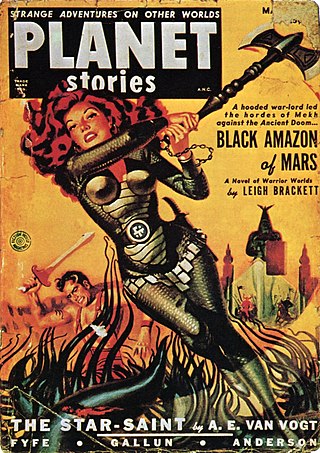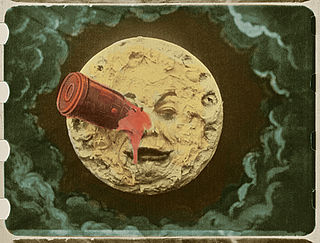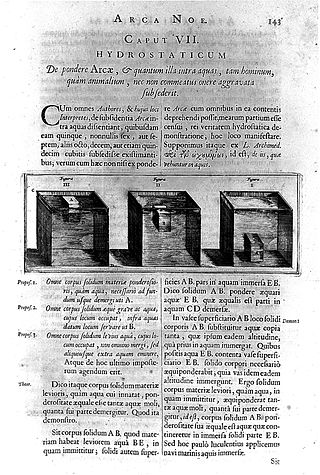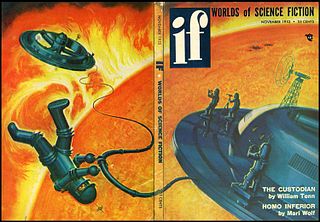
The Hollow Earth is a concept proposing that the planet Earth is entirely hollow or contains a substantial interior space. Notably suggested by Edmond Halley in the late 17th century, the notion was disproven, first tentatively by Pierre Bouguer in 1740, then definitively by Charles Hutton in his Schiehallion experiment around 1774.

Mars, the fourth planet from the Sun, has appeared as a setting in works of fiction since at least the mid-1600s. Trends in the planet's portrayal have largely been influenced by advances in planetary science. It became the most popular celestial object in fiction in the late 1800s, when it became clear that there was no life on the Moon. The predominant genre depicting Mars at the time was utopian fiction. Around the same time, the mistaken belief that there are canals on Mars emerged and made its way into fiction, popularized by Percival Lowell's speculations of an ancient civilization having constructed them. The War of the Worlds, H. G. Wells's novel about an alien invasion of Earth by sinister Martians, was published in 1897 and went on to have a major influence on the science fiction genre.

Athanasius Kircher was a German Jesuit scholar and polymath who published around 40 major works of comparative religion, geology, and medicine. Kircher has been compared to fellow Jesuit Roger Joseph Boscovich and to Leonardo da Vinci for his vast range of interests, and has been honoured with the title "Master of a Hundred Arts". He taught for more than 40 years at the Roman College, where he set up a wunderkammer. A resurgence of interest in Kircher has occurred within the scholarly community in recent decades.
Heinrich Roth was a missionary and pioneering Sanskrit scholar.

Planet Stories was an American pulp science fiction magazine, published by Fiction House between 1939 and 1955. It featured interplanetary adventures, both in space and on some other planets, and was initially focused on a young readership. Malcolm Reiss was editor or editor-in-chief for all of its 71 issues. Planet Stories was launched at the same time as Planet Comics, the success of which probably helped to fund the early issues of Planet Stories. Planet Stories did not pay well enough to regularly attract the leading science fiction writers of the day, but occasionally obtained work from well-known authors, including Isaac Asimov and Clifford D. Simak. In 1952 Planet Stories published Philip K. Dick's first sale, and printed four more of his stories over the next three years.

The planet Venus has been used as a setting in fiction since before the 19th century. Its opaque cloud cover gave science fiction writers free rein to speculate on conditions at its surface—a "cosmic Rorschach test", in the words of science fiction author Stephen L. Gillett. The planet was often depicted as warmer than Earth but still habitable by humans. Depictions of Venus as a lush, verdant paradise, an oceanic planet, or fetid swampland, often inhabited by dinosaur-like beasts or other monsters, became common in early pulp science fiction, particularly between the 1930s and 1950s. Some other stories portrayed it as a desert, or invented more exotic settings. The absence of a common vision resulted in Venus not developing a coherent fictional mythology, in contrast to the image of Mars in fiction.

The Moon has appeared in fiction as a setting since at least classical antiquity. Throughout most of literary history, a significant portion of works depicting lunar voyages has been satirical in nature. From the late 1800s onwards, science fiction has successively focused largely on the themes of life on the Moon, first Moon landings, and lunar colonization.

Gaspar Schott was a German Jesuit and scientist, specializing in the fields of physics, mathematics and natural philosophy, and known for his industry.

Uranus has been used as a setting in works of fiction since shortly after its 1781 discovery, albeit infrequently. The earliest depictions portrayed it as having a solid surface, whereas later stories portrayed it more accurately as a gaseous planet. Its moons have also appeared in a handful of works. Both the planet and its moons have experienced a slight trend of increased representation in fiction over time.
Ashen light is a hypothesised subtle glow that has been claimed to be seen on the night side of the planet Venus. The phenomenon has not been scientifically confirmed, and theories as to the observed phenomenon's cause are numerous, such as emission of light by Venus, or optical phenomena within the observing telescope itself. A modern hypothesis as to the source of light on Venus suggests it to be associated with lightning, for which there is some evidence on Venus. This theory has fallen out of favour, however, as there is not enough light generated by this lightning so as to be observed. A more recent hypothesis is that it is a form of transient aurorae or airglow caused by unusually high solar activity interacting with the upper Venusian atmosphere.
Imaginary voyage is a narrative genre which presents fictious locations in the form of a travel narrative, but has no generally agreed-upon definition. It has been subdivided into fantastic voyages and realistic voyages depending on the prominence of "marvelous or supernatural elements". It can be a utopian or satirical representation put into a fictional frame of travel account. It has been regarded as a predecessor of science fiction.

David Origanus or David Tost was a German astronomer and professor for Greek language and Mathematics at the Viadrina University in Frankfurt (Oder), where he had also studied.

Dying Earth is a subgenre of science fantasy or science fiction which takes place in the far future at either the end of life on Earth or the end of time, when the laws of the universe themselves fail. Dominant themes include world-weariness, innocence, idealism, entropy, heat death of the universe, exhaustion or depletion of many or all resources, and the hope of renewal. A related subgenre set in the distant future of entropic decay is called entropic romance.

Le Micromégas is a 1752 novella by the French philosopher and satirist Voltaire. Along with his story "Plato's Dream", it is an early example in the literary genre of science fiction and has its place in the development of the history of literature. Some uncertainty surrounds the first publication of Micromégas, with possible editions dating to 1751 or as early as 1739, but with the widely accepted publication being 1752.
Jean-Baptiste Benoît Eyriès was a French geographer, author and translator, best remembered in the English speaking world for his translation of German ghost stories Fantasmagoriana, published anonymously in 1812, which inspired Mary Shelley and John William Polidori to write Frankenstein and The Vampyre respectively. He was one of the founding members of the Société de Géographie, a member of the Société Asiatique, Académie des Inscriptions et Belles-Lettres, American Philosophical Society, and American Academy of Arts and Sciences, and was awarded the Legion of Honour. He had a mountain named after him near Yos Sudarso Bay in New Guinea, as well as a sandbank near French Island, Australia, and a street in Le Havre.

Arca Noë is a book published in 1675 by the Jesuit scholar Athanasius Kircher. It is a study of the biblical story of Noah's Ark, published by the cartographer and bookseller Johannes van Waesbergen in Amsterdam. Kircher's aim in Arca Noë was to reconcile recent discoveries in nature and geography with the text of the Bible. This demonstration of the underlying unity and truth between revelation and science was a fundamental task of Catholic scholarship at the time. Together with its sister volume Turris Babel, Arca Noë presented a complete intellectual project to demonstrate how contemporary science supported the account of the Book of Genesis.

Turris Babel was a 1679 work by the Jesuit scholar Athanasius Kircher. It was the last of his books published during his lifetime. Together with his earlier work Arca Noë, it represents Kircher's endeavour to show how modern science supported the Biblical narrative in the Book of Genesis. The work was also a broad synthesis of many of Kircher's ideas on architecture, language and religion. The book was dedicated to the Holy Roman Emperor Leopold I and printed in Amsterdam by the cartographer and bookseller Johannes van Waesbergen.

Arithmologia, sive De Abditis Numerorum Mysteriis is a 1665 work by the Jesuit scholar Athanasius Kircher. It was published by Varese, the main printing house for the Jesuit order in Rome in the mid-17th century. It was dedicated to Franz III. Nádasdy, a convert to Catholicism to whom Kircher had previously co-dedicated Oedipus Aegyptiacus. Arithmologia is the only one of Kircher's works devoted entirely to different aspects of number symbolism.

Ars Magna Lucis et Umbrae is a 1646 work by the Jesuit scholar Athanasius Kircher. It was dedicated to Ferdinand IV, King of the Romans and published in Rome by Lodovico Grignani. A second edition was published in Amsterdam in 1671 by Johann Jansson. Ars Magna was the first description published in Europe of the illumination and projection of images. The book contains the first printed illustration of Saturn and the 1671 edition also contained a description of the magic lantern.

The Sun has appeared as a setting in fiction at least since classical antiquity, but for a long time it received relatively sporadic attention. Many of the early depictions viewed it as an essentially Earth-like and thus potentially habitable body—a once-common belief about celestial objects in general known as the plurality of worlds—and depicted various kinds of solar inhabitants. As more became known about the Sun through advances in astronomy, in particular its temperature, solar inhabitants fell out of favour save for the occasional more exotic alien lifeforms. Instead, many stories focused on the eventual death of the Sun and the havoc it would wreak upon life on Earth. Before it was understood that the Sun is powered by nuclear fusion, the prevailing assumption among writers was that combustion was the source of its heat and light, and it was expected to run out of fuel relatively soon. Even after the true source of the Sun's energy was determined in the 1920s, the dimming or extinction of the Sun remained a recurring theme in disaster stories, with occasional attempts at averting disaster by reigniting the Sun. Another common way for the Sun to cause destruction is by exploding, and other mechanisms such as solar flares also appear on occasion.


















